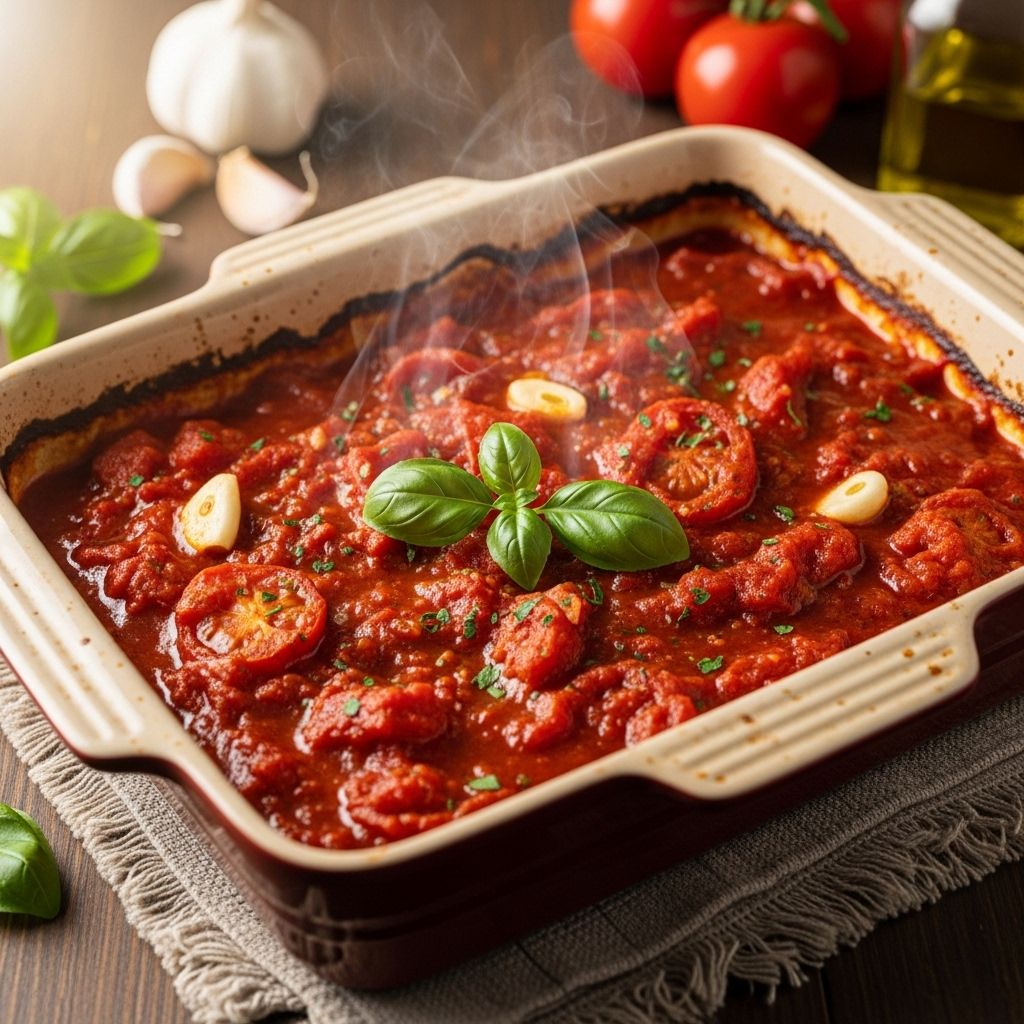Oven-Baked Red Sauce Recipe: 6 Simple Steps To Authentic Taste
A low-and-slow approach brings out rich, caramelized notes in every spoonful.

The Heart of Italian-American Red Sauce
Few foods invoke nostalgia, pride, and culinary camaraderie like a pot of slow-cooked Italian-American red sauce. Not marinara, not fresh pomodoro: this is the rich, thick, rib-sticking tomato sauce that powered family gatherings, Sunday suppers, and neighborhood feasts from New Jersey to Brooklyn. It’s the sauce that perfumes entire houses, fills bellies for hours, and offers a taste of both heritage and home.
While its roots stretch back to Italy, this particular sauce is an American invention: opulent, aromatic, and meant for generously smothering meatballs, chicken parmesan, or giant platters of spaghetti. The secret? Great ingredients and a long, low roast in the oven.
Why Oven-Baked Red Sauce?
The traditional method for red sauce involves stovetop simmering, but this approach often risks scorching and uneven reduction. By moving the sauce to a low oven, you enlist gentle, all-around heat that perfectly caramelizes flavors without constant supervision. This method delivers:
- Even heat distribution for gradual flavor development
- Deeper caramelization for a complex, layered taste
- Thicker texture without burning or over-reduction
- Less stirring: more hands-off than the stovetop
As the sauce bakes, the color deepens to a garnet red, and the aromas become intoxicating.
A Brief History: From Italian Roots to American Tables
Red sauce—sometimes lovingly called gravy—began as an adaptation. Italian immigrants drew on southern Italian traditions, but with access to abundant American tomatoes and affordable meats, they transformed their sauces into something richer, thicker, and uniquely their own.
- Fresh basil and olive oil took a backseat to slow-simmered meats and aromatics
- Sunday Sauce became a fixture of community, signaling togetherness, prosperity, and pride
- Restaurants and home cooks alike adapted the base to endless pasta dishes: meatballs, sausage, braciole, and more
Ingredients: Quality Matters
The most celebrated red sauces use a handful of everyday ingredients—each chosen carefully for maximum flavor. Here’s what you’ll need:
- Canned whole tomatoes (preferably San Marzano or high-quality Italian brands)
- Onion and garlic (the aromatics that create savory depth)
- Extra-virgin olive oil
- Fresh basil or dried oregano (for herbal notes)
- Salt and freshly ground black pepper
- Optional: red pepper flakes for a touch of heat
- Optional: meat or meat drippings (sausage, pork neck, or meatballs for extra savoriness)
Many families have their own variations—some add sugar to cut acidity, others a pinch of baking soda, or a spoonful of tomato paste for further depth.
The Essential Oven-Baked Red Sauce Recipe
Yield: About 4 quarts (enough for several family-style meals)
Ingredients List
- 3 (28-ounce) cans whole peeled tomatoes, crushed by hand or with a blender
- 1/4 cup extra-virgin olive oil
- 1 large onion, minced
- 6 cloves garlic, minced
- 1-2 teaspoons dried oregano or a few sprigs fresh basil
- Salt and black pepper to taste
- 1/4 teaspoon red pepper flakes (optional)
- Optional meats: 1/2 pound pork neck bones, Italian sausage, or 8 large meatballs
Instructions
- Preheat oven to 325°F (163°C). Place rack in lower-middle position for even heat.
- Sauté aromatics. Heat olive oil in a large Dutch oven over medium heat. Cook onion, stirring, until softened and translucent (about 5 minutes). Add garlic; sauté until fragrant (1-2 minutes). If using meat, brown well at this stage.
- Add tomatoes and herbs. Stir in the hand-crushed tomatoes and juices, oregano or basil, red pepper flakes (if using), and a generous pinch of salt and pepper. Bring to a simmer.
- Transfer pot to oven. Cover loosely with a lid, leaving a small gap for steam. Bake for 2 to 3 hours, stirring every 30-40 minutes, until sauce is thick and brick-red, and flavors are deeply developed.
- Finish sauce. Remove from the oven, discard any large herb stems or bones, and taste for seasoning. For an extra-smooth sauce, blend with an immersion blender or standard blender (cool slightly first).
- Serve, store, or freeze. Pair with pasta, ladle over meats, or cool and store in sealed containers. Sauce can be refrigerated up to 5 days or frozen for 3 months.
Technique Tips and Variations
- Crush tomatoes by hand for a rustic, traditional texture. Avoid pre-pureed tomatoes for best results.
- Balance sweetness and acidity: If sauce tastes too tangy, add 1 teaspoon sugar. For more acidity, a dash of vinegar can brighten flavors.
- Enrich and flavor with meats: Simmer pork neck bones, sausage, or meatballs directly in sauce. Their fat and juices add unmatched savoriness.
- Finish with fresh herbs: Stir in a handful of torn basil leaves just before serving for aroma and brightness.
- For extra silkiness: Swirl in a tablespoon of butter at the end.
What Makes This Red Sauce Special?
Unlike quick-cooked or jarred sauces, oven-baked Italian-American red sauce develops complexity through time:
- Maillard reactions occur, caramelizing vegetables and maximizing umami.
- Collagen in meats melts, thickening texture and deepening flavor.
- The oven’s radiant heat gently reduces liquid while preventing scorching, freeing you from constant stirring.
- Herbs and spices infuse slowly, lending depth without bitterness.
Pasta Pairings and Serving Suggestions
This versatile sauce forms the heart of countless comfort dishes. Suggestions include:
- Spaghetti with Meatballs: Tossed in sauce and topped with parmagiano-reggiano
- Chicken or Eggplant Parmesan: Baked with a ladle of sauce and gooey mozzarella
- Lasagna: Layered with ricotta, noodles, and more sauce
- Baked Ziti: Ziti pasta, sauce, sausage, and cheese, all bubbling from the oven
- Subs and Hoagies: Smothered in sauce for classic Italian-American sandwiches
For the ultimate effect, always serve with extra sauce on the side and plenty of fresh grated cheese.
Make-Ahead, Storage, and Freezer Tips
Red sauce is a dream for batch cooking and meal prep. Here’s how to make the most of your efforts:
- Make ahead: Flavor improves after a day or two in the fridge.
- Storage: Keep in airtight containers in the refrigerator for up to 5 days.
- Freeze: Ladle cooled sauce into freezer bags or containers. Freeze for up to 3 months. Thaw in the fridge or gently reheat from frozen on the stovetop.
Frequently Asked Questions (FAQs)
Can I use fresh tomatoes instead of canned?
Yes, but note that high-quality canned tomatoes provide year-round consistency and optimal flavor. Fresh, vine-ripened tomatoes can work in peak season, but peel and seed before use for best results.
How do I prevent sauce from being too acidic or bitter?
Simmering sauce slowly in the oven helps develop sweetness naturally. If needed, a teaspoon of sugar or a pinch of baking soda can round off excess acidity. Avoid burning the garlic and onions, as this introduces bitterness.
Is this sauce vegetarian?
It can be! Omit any meats or sausages. For added depth without meat, you can add a chopped carrot for gentle sweetness or a parmesan rind for umami (remove rind before serving).
What’s the difference between this and marinara sauce?
Marinara is generally lighter, quicker to make, and uses less meat or none at all. Oven-baked red sauce is slow-cooked, thicker, and heartier, meant for robust pasta dishes and covered meals.
Can I double or halve the recipe?
Absolutely. Use a sufficiently large Dutch oven for larger batches so the sauce has room to reduce and thicken evenly in the oven. Cooking times may need slight adjustment.
Table: Essential Differences—Stovetop vs. Oven-Baked Red Sauce
| Characteristic | Stovetop Sauce | Oven-Baked Sauce |
|---|---|---|
| Heat Source | Direct, bottom heat | All-around, gentle radiant heat |
| Flavor Development | Can be uneven, risk of scorching | Consistently caramelized, no burning |
| Texture | Sometimes too thin or too thick | Silky, rich, and perfectly thickened |
| Effort Level | Requires frequent stirring | Mostly hands-off, occasional stir |
| Recommended For | Quick meals, marinara | Big-batch, traditional red sauce/gravy |
Final Notes
The romance of Italian-American red sauce is as much about ritual as it is about flavor: the slow assembly, simmering oven, and unhurried anticipation. When you master this oven-baked red sauce, you’re not just recreating a recipe—you’re continuing a proud tradition, one spoonful at a time.
Invite friends and family, open your kitchen windows, and let the aroma of tradition fill the air.
Read full bio of Srija Burman












